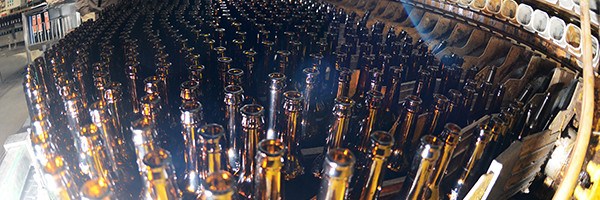AB InBev: Standardization and Cost-Efficiency

For the win.
Company Background
Anheuser-Busch InBev (AB InBev) is the world’s largest brewer, headquartered in Leuven, Belgium. In 2014, the company reported $47 billion of revenue and $18.5 billion of EBITDA, with 155,000 employees.
History of Growth by Acquisition
To understand the current structure and global presence of the conglomerate, it is important to know the merger history that created it. AB InBev was formed in 2008 through the merger of the American brewer Anheuser-Busch and InBev. InBev was formed in 2004 through the merger of Belgium-based Interbrew and Brazilian AmBev. AmBev was formed in 2002 through the combination of two Brazilian breweries, Brahma and Antarctica.

Business Model and Operating Model
AB InBev is extraordinarily effective at extracting value from its operations. Their business model is to control the beer market, vertically integrating as much as possible, while maintaining operations around the world to serve as many people as possible, as efficiently as possible.
To achieve these broad goals, AB InBev has established a clear operating model that relies on two main features:
- Strong Mergers and Acquisitions (M&A) Capability
A distinctly strong M&A integration ability is key to the success of AB InBev. As can be seen in the history of the company above, M&A has played a massive role in the current organizational structure, used to gain new customer segments around the world. Quick and successful integration capabilities are necessary to maintain organizational alignment towards common goals.
AB InBev sets a high bar here: the company is known for establishing integration, oversight, and change management programs to be started the day the merger or acquisition is validated. These programs include not just targets and goals, but standardized tools and processes to achieve the targets. This allows them to achieve five times the synergies of average consumer product company mergers. This capability and focus is a major sustainable competitive advantage for the company.
- Cost Efficiency and Financial Focus
Cost efficiency is one of AB InBev’s core competencies. This cost conscious culture is driven by the CEO, Carlos Brito, and heavily influenced by the style of the private equity firm 3G Partners, who owns a sizable stake in the business.
The company created an environment where every dollar spent must be justified. Management encourages employees to think of the company’s money as their own. Importantly, AB InBev relies on a concept called “zero-based budgeting”, where financial projections are built from the ground up, instead of common practice of using the previous budget or actual results and then adding a certain percentage spend increase.
The company maintains strong internal financial reporting and performance management systems so that profitability can be seen on a brand by brand level. This allows the company to employ a Focus Brands strategy, wherein they allocate the majority of their resources to brands with the best performance and greatest long-term potential.
Challenges to Operating Model
Recently, AB InBev approached SAB Miller for a merger that would account for north of 30% of the global beer market. This would be one of the largest mergers of consumer goods companies in history. The two companies are said to rely on two drastically different operating models, with SAB Miller known for decentralized decision-making and regional independence. This will test the capabilities of the standardization-focused operating model of AB InBev and the M&A integration team.
With this challenge comes opportunity, as AB InBev has the potential to yet again prove the success of its operating model and return large value to shareholders, employees, and customers.
References
AB InBev Company Website: http://www.ab-inbev.com/media/our-company.html
AB InBev Company Website: http://www.ab-inbev.com/investors/our-business.html
AB InBev Corporate Recruiting Website: http://www.ownyourfuture.ab-inbev.com/about-us/our-history/
Miles, Laura, Borchert, Adam, Egan, Alexandra. “Why Some Merging Companies Become Synergy Overachivers” Bain & Company, August 13, 2014. http://www.bain.com/publications/articles/why-some-merging-companies-become-synergy-overachievers.aspx
Cooper, David, Dhiri, Sanjar, Root, James. “Winning Operating Models” Bain & Company, September 14, 2012. http://www.bain.com/publications/articles/winning-operating-models.aspx
Geller, Martinne. “AB InBev seen reining in SABMiller’s decentralized culture.” Reuters, October 6, 2015. http://uk.reuters.com/article/us-sabmiller-abinbev-culture-idUKKCN0RZ1UL20151006
McMains, Andrew, Parpis, Eleftheria. “Why ABInBEV Scuttled ‘Underutilized’ Shops.” Adweek, March 23, 2009, Vol. 50, Issue 12



Great post, Tom. Though I’m now convinced that InBev is an evil empire… While their operating and business models seem well aligned, as you pointed out with the Miller merger, they may face difficulties when bringing this operating model to companies they acquire. I could especially see this being the case if they acquired smaller, independent labels whose value proposition is not the same as that of InBev (quality vs. quantity/availability). Is there evidence that InBev ever destroys the value created by one of these smaller breweries? Or is there ability to scale and get a beer out to the masses a surefire success strategy?
Really interesting post, Tom. Given its emphasis on a cost-conscious culture where every dollar needs to be justified, I’m curious how successful InBev has been recently at attracting top junior talent to the organization.
My sister currently works for Kraft Heinz, another 3G Capital company, and constantly talks about how the quality of life for junior employees is pretty terrible. She works private equity-like hours due to 3G’s mandate, but isn’t compensated in-kind due to the cost-cutting mentality of the owners. I wonder how, in an attempt to streamline the business to run like a finance-driven enterprise, InBev is competing to attract talent from banks, PE firms and tech companies, which provide M&A-inclined graduates with higher pay, and countless perks / benefits. A constant pipeline of talented individuals is likely a major part of InBev’s recent M&A / integration success, so I’d be curious about it’s sustainability going forward given there are more options in the market.